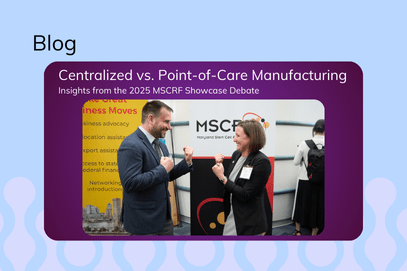RoslinCT Blog Series: Scientific Advisory Board Perspectives
Margit Jeschke, RoslinCT SAB Member
Bringing Clarity to Complexity
Cell therapies are among the most complicated modalities ever developed. Not surprisingly, characterization of these therapeutics is challenging. Unlike small molecules and recombinant proteins such as monoclonal antibodies, cell therapies are extremely complex, highly variable, and are being developed within an evolving regulatory landscape. We spoke with Margit Jeschke, Ph.D., member of the RoslinCT’s Scientific Advisory Board about strategies for characterizing cell therapies.
After earning a Ph.D. in biochemistry, Dr. Jeschke moved from the research setting into industry with a goal of having a greater impact in addressing difficult medical problems. She joined the newly formed cell and gene therapy organization at Novartis in 2012 after holding several roles within the company which included leading analytical R&D for Novartis Biologics in Basel, Switzerland. She built and led the initial cell and gene therapy technical development team that enabled production and commercialization of CTL019/Kymriah and was responsible for the analytical content in the registration dossier of the first CAR-T product to receive FDA approval.
The Characterization Challenge
Prior to cell therapies joining the roster of drug modalities, medicine cabinets and pharmacy shelves were predominantly stocked with small molecules and proteins. Small molecules and proteins are relatively simple in terms of their structures and many analytical tools are available for thorough characterization. Conclusions and predictions drawn from analytical results facilitate studies such as comparability after manufacturing changes are introduced.
“You can fully analyze a small molecule and know everything about it,” said Dr. Jeschke. “With cell therapies, you have a broader range of analytical tools to consider and decisions to make because you can’t analyze everything. The high patient-dependent variability of the starting material for autologous products makes it very difficult to design a comparability study, for example.
Allogeneic cell therapies offer the potential for “off-the-shelf” availability, allowing the treatment of many patients with one batch. For these therapies, the possibility of immune reactions against donor cells (graft-versus-host disease), and other donor cell-related risks such as genetic or functional instability or the presence of adventitious viruses require analytical attention. For induced pluripotent stem cells (iPSCs) based products, analytical testing is also essential to ensure the product is composed of differentiated cell types of the intended lineage and to confirm the absence of residual undifferentiated iPSCs.
Dr. Jeschke notes that there is continuous development of regulatory guidelines and better collaboration among the major regulatory bodies, which is helping to standardize analytical packages. In addition, use of risk-based approaches, such as those included in guidelines from the International Council for Harmonization of Technical Requirements for Pharmaceuticals for Human (ICH), are particularly helpful during cell therapy development.
“In the absence of data in the beginning of analytical development, we need to use educated guesses, review existing knowledge, and have a good understanding of biochemistry and human physiology, and -most importantly- the mechanism of action of the product. Then you apply risk-based approaches to determine the testing strategy. A broad characterization is typically used to identify critical quality attributes. Based on a list of relevant attributes, you test as many as possible or as many as are meaningful. Of course, that’s always a very interesting discussion among the analytics, quality, and regulatory teams.”
“With cell therapy, we see a tremendous amount of manufacturing changes happening not only during development, but also changes of commercial products because the field is so rapidly evolving. Also, the manufacturing equipment is getting better, and more automation can be implemented. If you have well developed analytical characterization tools in place, you can much more effectively perform a comparability study and confirm that the change(s) implemented do not impact product quality. These analytics play an essential role, far more important than for any other type of product.”
The Importance of Continuity with your CDMO
Dr. Jeschke highlighted the need for not only close collaboration with your CDMO with regards to the analytical package but also long-term continuity.
“Collaboration in our field will not be simple ‘make-for-payment’ contracts; CDMOs also need to be involved in answering questions from health authorities. Everything is so much easier if you maintain continuity because you don’t want to find yourself in a situation where you have a product, but the contract manufacturer is no longer a partner. After method transfer, your new CDMO may not know why the original CDMO developed a certain assay in a particular manner. The development and validation of assays to be filed will be subject to questions from the regulatory agencies.”
What’s On the Horizon
One of the biggest questions that I typically address when I am working with teams is what is needed for GMP compliance in cell derivation. It is very different than a typical GMP process where you are starting with a defined material, and you get a defined drug product out. The key for an iPSC derivation and editing process is that it is very well documented with an understanding of the risks introduced by the materials used for reprogramming and editing. In the end, regulators typically focus on understanding potential risks introduced during cell line derivation. A solid documentation package with a thorough risk assessment goes a long way in addressing the key questions.
The resulting clone with all the right attributes goes into a master cell bank and working cell bank. At that point, we go to more of a typical GMP manufacturing process. But even then, it still is wise to take a risk-based approach because these complex differentiation processes are coming from the research environment, and typically, there are many changes that are needed to make it more ideal from the standpoint of scalability and GMP compliance. But if you try to make all of the process changes at once, you can really end up with a headache. So, it is wise to have a partner that you can work with that understands the set of possible risks and which are important to address early in the development continuum, versus which of those can be pushed to a later stage of development.
When it comes to analytical areas the industry continues to wrestle with, potency is top of mind for Dr. Jeschke.
“Potency testing itself, along with understanding which factors might predict clinical outcomes and what functional testing is sufficient and meaningful for product batch release, is a very hot field. There have been approval delays that result from challenges in developing appropriate potency assays. Developing and performing these assays are costly endeavors and we see very high variability, most of which is patient dependent.”
Another area of intense focus is the need for new analytical tools to significantly reduce the costs and the time for release testing. While very good analytical tools for small molecules and proteins have been developed over the course of decades, the array of tools for cell therapy is not quite there yet, according to Dr. Jeschke.
“The tools we have right now tend to be very time- and cost-intensive such as flow cytometry. We need to be able to analyze cells in a more cost-effective way and provide shorter turnaround times because in contrast to other drugs modalities, we often have patients waiting in very critical condition.”


